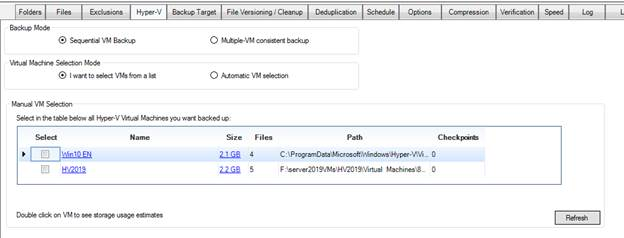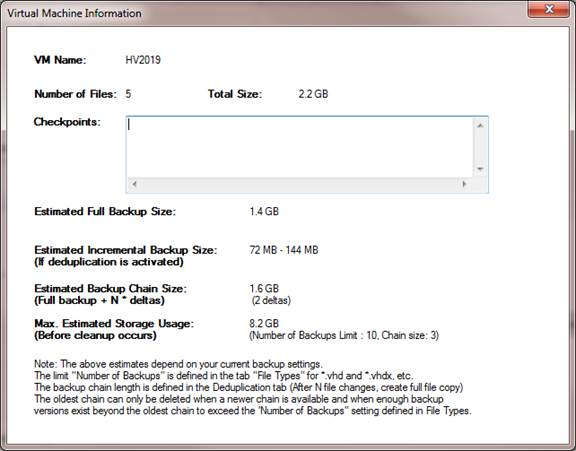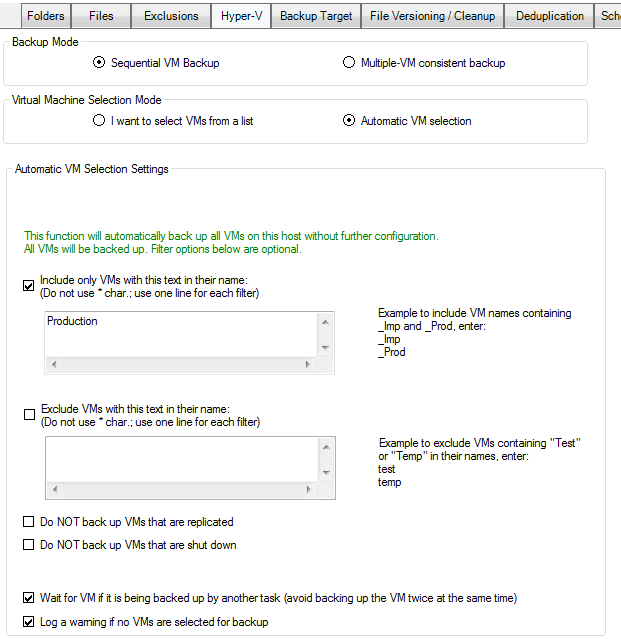Adding Hyper-V Virtual Machines to Backup Tasks
For detailed product information, please visit the BackupChain home page.
On a Windows Server 2008 – Windows Server 2022 with Hyper-V role installed, or on a Hyper-V Server 2008 R2 / 2012 / 2016 / 2019 or Windows Core installation, you may back up Hyper-V virtual machines using BackupChain’s Hyper-V tab.
The Hyper-V tab is not available in the BackupChain Professional Edition. However, on Windows 11 – 8 PCs using Hyper-V or other virtualization platforms, the Server Enterprise for PCs Edition may be used, which contains the full feature set as shown below.
Inside the Hyper-V tab are two major sections, which differ in the selection mode that is being offered. You can either ‘select VMs from a list’ by hand or use the “Automatic VM Selection” feature.
The Automatic VM Selection feature is only available in Server Enterprise and Platinum editions.
Manual VM Selection
The manual selection feature allows you to select the VM from a list:

If the VM you selected is not present at the time of backup, the VM will be skipped and an error will be logged. In environments where VMs are moved, either automatically or manually, it’s best to use the automatic VM selection feature presented in the next section.
VM Backup Size Estimation
By double-clicking on the blue links above (the VM name or size field), a new screen will open with detailed size information that is based on your current backup settings. The screen will help you figure out how much space you need to back this VM up, depending on current backup settings and the VM’s actual current size:

As you can see above, the VM’s size is reported as full backup size, which is the current size in uncompressed form. If your backup task has deduplication and compression switched on, the screen shows estimated sizes for increments and full backups. The estimates use 5-10% of compressed size (60% estimate) as rule of thumb. If you switch deduplication and/or compression off, the estimates will update accordingly to reflect the new backup configuration. Note that the traditional backup scheme consists of a full, compressed backup followed by a number of increments or differentials. This forms one backup chain. After completion of one backup chain, a new one is created for easier management and faster restore operations. Once a new backup chain is created, and only then, BackupChain can try to delete the oldest backup chain, if your cleanup settings require it (see tab “File Versioning / Cleanup”).
Automatic VM Selection Feature
The automatic VM selection feature allows you to configure a ‘set it and forget it’ type of backup configuration and handles the case where certain VMs may move in and out of hosts and certain VMs might be for testing only and do not require backup.
The screen is shown below:

The above screen uses a text to match the VMs that we want backed up: “Production”. This means that we have configured our VMs in Hyper-V Management to use the word “Production” somewhere in the VM’s name. When BackupChain starts the task and sees VMs with the word Production in their name, they will be automatically included to the backup task.
If you don’t provide an inclusion filter, all VMs are included.
In addition, you can exclude VMs based on their name as well. In above exclusion box, you could enter ‘test’ without the quotes to let BackupChain omit those VMs that contain the word test in their name.
Furthermore, you can omit backups for VMs that are being replicated or that are shut down.
Nnote: If you decide to not back up VMs that are shut down, this will lead to potential data loss. If the VM was backed up live and subsequently turned off, the last backup will be from the time it was running and will not include the changes that have occurred since the last backup. A VM that just happens to be always switched off when the backup task runs, will never be backed up because it will never be seen running at the time when the backup starts. Please keep such potential side-effects in mind when using these filters.
If no VMs are selected for backup, by default, a warning is logged, which you can turn off. There are cases where all VMs are moved intentionally to another host. In such cases you probably do not want the warning to occur and hence you would uncheck that option.
The wait option above is for situations where a VM cannot be backed up simultaneously; hence, BackupChain would need to wait for the other backup (or conflicting operation on the VM) to finish first. It’s highly recommended to leave this option on, unless you know for sure the VM can handle simultaneous backups. Some services internal to a VM might use exclusive locks in internal databases and hence backups will fail if run simultaneously. Potentially this can occur with certain SQL Server and Exchange Server databases, which are set up in a way that does not allow for simultaneous backups.
Note: You need to select “Hyper-V Backup (Server)” when creating a new task in order to use these screen. In addition, if the task was created using the “Universal Backup” option, the option “Backup all VMs simultaneously” will remain checked and cannot be switched off.
Note: On Windows Server 2012 and later versions, do not use Universal Backup to backup Hyper-V; use Hyper-V Backup task types instead to back up Hyper-V virtual machines.
To back up a Hyper-V virtual machine, including its snapshots and configuration, simply select it from the list or use the automatic VM selection mode. If you select several virtual machines and want them backed up simultaneously, select the option “Backup all VMs simultaneously”. On a very busy system you may want to back up your VMs one after another instead.
Note: Sequential virtual machine backup is supported for tasks that were created using the “Hyper-V Backup” option only.
Note: Do not use the simultaneous backup option in an attempt to cut down backup time. It may actually shorten the backup time a little but at the expense of much greater resource consumption. In a typical Hyper-V host environment most users prefer to keep their backup process in the background without much interference with the rest of the system. If you uncheck the option “Backup all VMs selected above simultaneously” BackupChain will back up the selected VMs sequentially. Sequential backup is almost as fast as the simultaneous option but much more efficient because it involves only one virtual machine at a time in the backup process.
You may need to click “Refresh” if you added a new VM after BackupChain was started.
Note: If you use the Granular Backup option you do not need to check the VM here again, unless you also want a full backup of your VM in addition to selective VM folder backups.
Backup Software Overview
The Best Backup Software in 2026 Download BackupChain®BackupChain Backup Software is the all-in-one Windows Server backup solution and includes:
Server Backup
Disk Image Backup
Drive Cloning and Disk Copy
VirtualBox Backup
VMware Backup
FTP Backup
Cloud Backup
File Server Backup
Virtual Machine Backup
Server Backup Solution
Hyper-V Backup
Popular
- Best Practices for Server Backups
- NAS Backup: Buffalo, Drobo, Synology
- How to use BackupChain for Cloud and Remote
- DriveMaker: Map FTP, SFTP, S3 Sites to a Drive Letter (Freeware)
Resources
- BackupChain
- VM Backup
- Knowledge Base
- BackupChain (German)
- German Help Pages
- BackupChain (Greek)
- BackupChain (Spanish)
- BackupChain (French)
- BackupChain (Dutch)
- BackupChain (Italian)
- BackupChain Server Backup Solution
- BackupChain is an all-in-one, reliable backup solution for Windows and Hyper-V that is more affordable than Veeam, Acronis, and Altaro.

